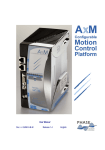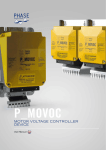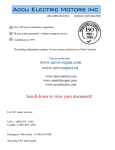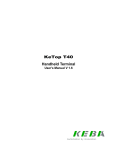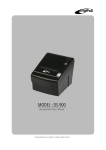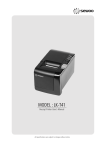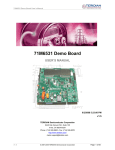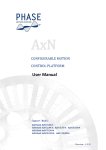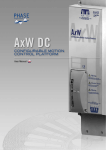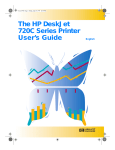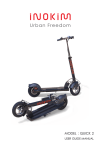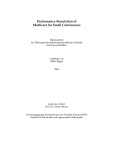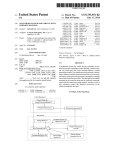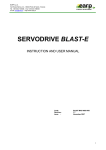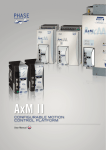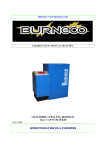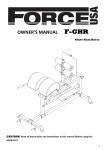Download MotorS with integrated Servodrive
Transcript
TW MotorS with integrated Servodrive User Manual Conformities Declaration of Conformity For PMC components there are declarations of conformity available. These declarations confirm that the components are designed according to valid EC directives. If required, you can ask your sales representative for these declarations. Low-Voltage Directive The PMC products of a drive system mentioned in this documentation comply with the requirements of the EC Directive (see page 67). Safety Instruction Please read before the initial startup. See page 73. EMC Directive The PMC products of a drive system mentioned in this documentation comply with the requirements of the EC Directive (see page 67). CE Label TW MotorS with integrated Servodrive User Manual Supported Models Size 3 302.50.4 Size 7 720C.40.3 730C.30.3 740C.20.3 summ summary 1 introduction torquewire Motors 1.1 TW motors with integrates servodrive . 8 1.2 Content of the package .................. 9 1.3 Optional CANPS-S1 – CAN Ixxat Interface module .......................... 9 1.4 Optional brake unit and power supply . 9 2 electrical installation 2.1 2.2 2.3 2.4 General connections design .......... 30 Power connections ...................... 00 Signal connections: CAN protocol ... 13 Signal connections: EtherCAT protocol ................................. 14 3 Software 3.1 Motor Led Behaviour ................... 16 3.2 Drive functionality ...................... 17 3.3 Standard CANOpen setting ........... 17 4 | tw motors with integrated Servodrive mary 4 tw Motor: size 3 7 4.1 4.2 4.3 4.4 4.5 4.5 Technical data ............................ 20 Mechanical drawings ................... 20 Torque (Nm) versus Speed (rpm) ... 21 Motor/drive technical data ........... 21 Standard Connectors ................... 22 New Connectors.......................... 22 7.1 TW-S Single phase ...................... 34 7.2 TW-T Three phase ....................... 34 7.3 CAN-PC Interface Board .............. 34 5 tw Motor: size 7 8.1 ? .............................................. 36 5.1 5.2 5.3 5.4 5.5 Technical data ............................ 24 Mechanical drawings ................... 24 Torque (Nm) versus Speed (rpm) ... 25 Motor/drive technical data ........... 25 Connections ............................... 26 9 6 Ce conformity 6.1 6.2 6.3 6.4 Introduction: EC directives ........... 28 LVD Directive ............................. 28 Product Safety ........................... 28 Application as Directed – Scope of Application ................................ 29 Installation ................................ 29 EC Declaration of Conformity and Directive EMCD .......................... 29 The EMCD directive 2004/108/CE Installation as Specified .............. 30 EC Declaration of Conformity ....... 31 6.5 6.6 6.7 6.8 6.9 8 tw accessories tw Motors: permissible shaft load safety instruction 9.1 Important directions for use ......... 38 9.2 Safety Instructions for Electric Drives and Controls .............................. 39 9.3 Instructions with Regard to Specific Dangers ..................................... 41 appendix Service and Support ........................... 48 Summary | 5 1 introduction: torquewire motors Phase Motion Control TW Motors with Integrated Servodrive T he new TorqueWire series of integral servo systems sets a new style in complex automatic machinery architecture. TorqueWire motors are complete, self sufficient servo axis building blocks which allow the design, integration and operation of large multi axis systems with minimum hardware and surprising ease. The TorqueWire motor system consists of an advanced, high performance rare earth brushless servo motor, a DSP based, high voltage interpolating servo drive and a single or multi turn absolute encoder, all assembled in a very compact IP 67 protected frame. The motor systems are controlled via a multi drop CANOpen field bus (or EtherCAT filed bus), linking together groups of motors on a single bus system. The motors are supplied from a common DC bus and braking energy from any drive is intrinsically recycled on any other axis on the network. The performance of TorqueWire originates in the advanced design of both motor and drives. The motor parts take advantage of a novel, patent pending winding design, along with new magnetic materials and a special winding technique, all of which result in a servo motor with about 60% of the size of a conventional servo design. Such advantage is invested in both temperature rise derating and space for the drive, so that TorqueWire motors, including the drive, are smaller than comparable motors with similar rating. The built-in, DSP based drive is a step forward in power drive miniaturization. According to the established Phase drive technology, neither electrolytic capacitors nor any components subject to ageing of temperature decay are used. All magnetic are planar, integrated in the drive PCB. The drive is an ultra compact, single board unit in high density SMD technology with no massive components and is vibration tested to 200 Hz, 5g. The drive is conformal coated and sealed; connection is via IP 67 industrial circular connectors. Drive temperature, long considered the limiting factor in integral drives, is controlled with an accurate strategy; all components are rated for 120 °C operation, while the drive is temperature limited at 100 °C. The DSP senses motor temperature, power device temperature, and drive ambient temperature. All these data are available on the bus for application monitoring and optimization. Drive loss and EMI are minimized intrinsically by the drive location, with zero wiring stray capacitance and minimized winding capacitance. In general, all servo systems are intrinsically limited in performance by the S/N ratio of the encoder signal. In the TW motors, the interpolating drive is positioned in close proximity of the encoder, thus ensuring the best possible position signal quality and integrity; the servo performance is consequently optimal. 1.1 TW motors with integrated servodrive The CANOpen protocol implementation of the TW series is in full compliance with the standards DS 301 and device profile drives DSP 402v2.0. TW drives are controlled in space, speed or torque. The servo loops are updated at 4 kHz frequency. In the interpolated mode, a position profile synchronized with other axes is followed with a maximum throughput of 500 samples/sec, corresponding to a maximum mechanical bandwidth of 250 Hz, far in excess of the best mechanical systems available; The TW interpolates points with a second order spline. A separate, programmable, hardwired I/O which overrides all software instructions is provided to cater for machine safety requirements. The 2 wires, optically isolated digital interface, and the suppression of all other interfaces, grants reliability, fault tolerance and ease of installation, especially in multi axis systems. The motors can be programmed and monitored via the CAN Cockpit configuratore windows interface (supplied with all TW motors). All TW motors embody a non volatile memory to store permanent data, settings and fault conditions irrespective of power supply availability. 8 | TW Motors with Integrated Servodrive 1.2 Content of the package Tw Motor with integrated servodrive including: • • • • absolute multi-turn (N), absolute single-turn (M) encoder or two-poles resolver (R); optional integrated holding brake (B); optional shaft forelock (K); CANOpen compatible (CiA DS301 V4.02 and DSP402 V2.0) drive, profile position, profile velocity, homing mode, interpolated mode, rotary table and torque profile (Tw specific); • default values on the parameters table (§4). Cdrom Phase Motion Control including: • • • • • user manual; software manual; a copy of the firmware and the related parameters table; Cockpit software (§6); Phase Motion Control products’ documentation. For a detailed description of all functionalities of the Tw motor, please refer to the Software manual (§4). 1.3Optional CANPC-S1 – CAN Ixxat Interface module The Cockpit configuration tool is useful to create, analyze, modify and copy all parameters for your applications. This tool has to be installed on a PC, together with the RS232 – CAN CANPC-S1 converter or with CanUsb-Ixxat converter. The Cockpit let the user to access to all functionalities and to all parameters of the drive; it can identify the unit, it let to read all parameters from it and save them on a backup file, it let to load the firmware when necessary. Further, it let to make powerful diagnostic with the Monitor Page, Monitor window and Graphic window functions (§6). The Cockpit could be used simultaneously with other devices in the CAN network only if there is no other systems that try to access via SDO protocol the same Tw that Cockpit is addressing (§4). Additionally, with the provided CAN Diagno tool, it is possible to sniffer the traffic on the CAN bus and to inject customized messages (§5). 1.4Optional brake unit and power supply This device make straightforward the commissioning of the Tw motors, as it combine in one system a power supply (EMI filter + rectifier bridge + capacitor filters, input supply of 220/380Vac, output supply of 310/560Vdc, short-circuit protected), a capacitors pre charge and a clamp unit. It can supply at the same time more than one Tw (§7). The EMI filter is effective up to a maximum of two Tw motors. Introduction: TorqueWire Motors | 9 2 electrical installation Phase Motion Control TW Motors with Integrated Servodrive 2.1 General connections design For the commissioning the Tw motor need only two connections: a supply connection (power / holding brake / auxiliary digital input) and a signal connection (CAN bus, passthrough male and female M12 connectors). DC link Brake Supply Unit Figure 1 General connections design (TW3 motors) CANOpen or EtherCAT communication CANOpen line Master CANopen TW7 2.2 TW3 Power connections The integrated servodrive is designed to work with a 540Vdc supply (that is the resulting rectified and filtered 380Vac) on TW3 e TW7 motors version. TW7 TW3 Figure 2 Power connections sample (TW3 motors) with TW-S Single Phase Supply (§ 7.1) DC- 220 Vac 220 Vac 12 | TW Motors with Integrated Servodrive DC+ As described by the previous drawing, the same DC bus can supply several motors in parallel. No clamp resistor is integrated into the motor. If the working cycle of the motor requires a significant braking energy dissipation, a bigger capacitor or an external clamp device should be installed on the DC bus. Both power supply and clamp device jobs are done by the optional Brake Unit and Power Supply module, as shown in the Figure 2. A nominal current’s sized shielded cable (high-flessibility kind suggested) is required for the system reliability. For EMI reduction an external filter (like Schaffner FN 350 series) between AC connection and rectifier should be installed. However, if the system employs the Brake Unit and Power Supply Module, it has a built-in filter suitable up to two motor. On the power connector there is also the software configurable auxiliary digital input that could be used either as emergency stop or as input to sample internal values by external event nor as zero point switch in the homing procedures. When requested, on the power connector there are also the holding brake commands. For proper operation the holding brake have to be supplied with a 24Vdc; inside the Tw this voltage is galvanic fully isolated from the power supply and from the other signals. 2.3 Signal connections: CAN protocol The CAN bus is a network, resistor terminated at the beginning and at the ending side, that pass through all devices that is linked to the net. It is necessary a twisted pair cable (highflessibility and shielded kind suggested) with line impedance equal to 120Ω; if the overall network is longer than 25m, it is required right size wires to avoid excessive power loss, as stated in the following table (referred to a network with no more than 64 nodes): Bus length [m] Resistance per length unit [mΩ/m] Wires size [mm2 (AWG)] Termination resistor (RT) [Ω] Baudrate [kbit/s] 0...40 70 0.25...0.34 (23…21) 124 1000 at 40 m 40...300 <60 0.34...0.6 (21...19) 150...300 >500 at 100 m 300...600 <40 0.5...0.6 (20…19) 150...300 >100 at 500 m 600...1000 <26 0.75...0.8 (19…18) 150...300 >50 at 1 km In the Tw motor, in order to let an easier harnessing, there are two M12 connectors, one male and one female. All signals on the connectors are opto-isolated. The power supply of the signal interface is self-generated (thus voiding an external specific power supply) and it is galvanically isolated from the main drive. Electrical Installation | 13 Drive AxM II Figure 3 Signal connections sample: CAN protocol. TW3 TW7 TW3 TW7 In the previous drawing is illustrated an interconnection sample between different CAN devices (four Tw motors, one AxM servodrive). Formoredetailsreferto(§1)andto(§4). 2.4 Signal connectionS: etherCat ProtoCol The EtherCAT technology overcomes the system limitations of other Ethernet solutions: the Ethernet packet is no longer received, then interpreted and copied as process data at every connection. Instead, the Ethernet frame is processed on the fly: the newly developed FMMU (fieldbus memory management unit) in each slave node reads the data addressed to it, while the telegram is forwarded to the next device. Similarly, input data is inserted while the telegram passes through. The telegrams are only delayed by a few nanoseconds. EtherCAT can provide the same communication mechanisms as the familiar CANOpen mechanisms: object dictionary, PDO (process data objects) and SDO (service data objects) - even the network managementiscomparable.Formoredetailsreferto(§8). 14 | tw motors with integrated Servodrive 3 SOFTWARE Phase Motion Control TW Motors with Integrated Servodrive 3.1 Motor Led Behaviour The Tw Motor is equipped with two couples of leds, which indicate the motor status (led on the upper and lower side of the motor give redundant information, except when different noted). Led1 Led2 Motor Status Blinking Off Power supply Ok. Power output disabled On Blinking Power supply Ok. Power output enabled Blinking alternately Fault condition Blinking simultaneously Waiting for firmware download (due to Firmware download activation or wrong firmware CRC check) Off Two fast blink Low DC link circuit voltage On (one side) Off (both side) Flash memory corrupted, contact technical service 16 | TW Motors with Integrated Servodrive 3.2 Drive functionality The Tw Motor complies with the CAN 2.0A standard, with 11 bit identifier; furthermore it complies with the CiA DS301 V4.02 (Application Layer and Communication Profile), with the following functionalities: NMT: Slave only Baud rate / node-ID: 1000 / 800 / 500 / 250 / 125 / 100 / 50 kbps; node 1 ÷ 127 Server SDO: 1 Tx PDO: 8 Rx PDO: 8 PDO Mapping: User programmable (only in pre-operational state) PDO Modes: All types supported Emergency object: Yes Sync object: Yes Time object: No Error control protocols: Boot-up / Node Guarding / Heartbeat The Tw Motor complies with some functionalities of the CiA DSP402 V2.0 (Device Profile Drives and Motion Control), that are: • • • • • Profile position mode. Profile velocity mode. Interpolated position mode. Factor group. Homing mode. The baud rate and node-id setting are provided by the CiA DSP305 V1.1 (Layer Setting Services protocol). The Tw Motor specific functions are: • • • • • Absolute multi-turn or absolute single-turn encoder. Torque (current) mode. Auxiliary digital input for emergency disable. 2nd order digital filters. Rotary table control. 3.3.Standard CANOpen setting Setting the node number and baud rate is supported by the protocol CiA DSP305 V1.1 (Layer Setting Services protocol). The factory default setting for the Tw Motor is the following: Node number: Baud rate: 1. 125 kbps (according to CiA DS301 V4.02). Software | 17 4 TW MOTOrS SizE 3 Phase Motion Control TW Motors with Integrated Servodrive 4.1 teChniCal data High torque density, small size, low inertia, high voltage supply, high speed. Torque continuous 3 Nm, peak 8 Nm. Maximum power density 650 W in 2.8 kg including drive 5000 rpm operation. Small diameter for limited pitch multi axis applications. 310 Vdc and 550 Vdc bus compatible. Universal 14 mm shaft with half key. Resolver, single turn and real multi turn absolute encoder without battery (17 bits/turn, 4096 turns, 1 arcmin accuracy). IP 67 protection. Applications: • Workpiecesettingforwoodandmetalforming. • Packaging,bottling,wrapping,especiallyonrotarymachines(singlewirecommendfor multi axis). • Toolchangers. • Laserplotter. • Pickandplacerobots. • Mouldautomation. • Assemblymachines. 4.2 meChaniCal drawingS. All measurements are in mm, except when specified. TW motor 302.50.4 302.50.4.B Units L1 197.4 227.4 [mm] L2 167.4 197.4 [mm] 20 | tw motors with integrated Servodrive 4.3Torque (Nm) versus speed (rpm) 7 TW 302.50.4 6 Torque (Nm) 5 4 3 2 Torque cont. S1 (flanged) 1 Torque cont. S1 (free air) 0 Torque max S6 10% (flanged) 0 1000 2000 3000 4000 5000 Speed (rpm) 4.4 Motor/drive technical data Reference data (winding independent) Symbol 302.50.4 Units Nominal Torque, S1, low speed, free air 1) Tnc 2.36 Nmrms Nominal Torque, S1, low speed, flanged 2) Tnw 2.50 Nmrms Peak Torque, S6 10% 1) Tpk 6.00 Nmrms Maximum speed Pn 800 rad/s Symbol 302.50.4 Units Jm 0.094 mkgm² Acceleration at peak torque Apk 67000 rad/s² Mass Msta 2.8 Kg Physical data (winding independent) Rotor inertia Insulation Class H-F IP Protection Thermal data (winding independent) IP67 Symbol 302.50.4 Units Thermal time constant, free air 1) Tc 400 sec Thermal time constant, flanged 2) Tw 145 sec W Motor loss at Tnc LOc 62 Motor loss at Tnw Low 72 W Threshold of built-in PTC PTCt 110 °C Units Symbol 302.50.4 Power supply (typical) Electrical data (winding dependent) Vn 540 Vdc Rated speed, flanged 3) Wn 500 rad/s Peak current T=Tpk Ipk 5.50 Arms Arms Nominal current at T=Tn Rated power, flanged, speed.3) Torque constant Brake Data (optional) In 2.0 Pnw 0.60 kW Kt 1.09 Nmamp-1 Units Symbol 302.50.4 Supply voltage Un 24 V Power consumption P20 13 W Stall braking torque Tbk 7.00 Nm Additional Inertia JBk 0.041 mkgm² 1) Motor in free still air (worst case), ambient 40 °C, copper 130 °C, frame 105 °C. 2) Motor mounted on steel flange, temperature flange <= 60°C. 3) Speed achievable only for flanged motor. TW Motors: Size 3 | 21 4.5 TW3 STANDARD connector Power Connector M23 Size Signal Connector M12 Size - CAN Protocol Connection 3 2 4 2 6 1 C Power connector 2 3 FEMALE MALE Pin Description DC+ 3 1 Shield 4 Connector Signal Connector M12 Size - CAN Protocol Connection 2 +24 V Supply2 3 GND6 3 CAN GND3 / O5 V Supply 5 1 Signal Connector 4 4 Auxiliary Input (+24 V) 4 Can-H 5 Can-L 2 1 5 O CV Supply B 3 5 6 1 +24 V Supply D 4 2 3 2 FEMALE 3 5 B Signal Connector MALE1 1 4 5 2 4 3 FEMALE MALE A 4.6 1 M12 Size - CAN Protocol Connection 4 C 2 4 M12 Codfication A Description 2Power DC- 5 4 Signal connectors CONINVERS 6 pins SF-SEP1N8AWA00 MR23 M23 Size 1 1 5 B Power Connector Pin 1 5 3 TW3 new connector version M12 Size - EtherCAT Protocol Connection Power Connector 2 2 5 3 1 5 3 1 Signal Connector M12 Size - CAN Protocol Connection 4 4 FEMALE FEMALE 2 3 1 4 2 3 D B Signal Connector 1 1 4 5 4 3 FEMALE MALE A C 5 2 M12 Size - EtherCAT Protocol Connection 2 3 5 2 1 3 5 1 4 4 FEMALE FEMALE Power connector Signal connectors CONINVERS 8 pins SF-7EP1N8AWA00 MR23 CANOpen protocol EtherCAT protocol M12 Codification A M12 Codification D Pin Description Pin Description Pin Description 1 DC+ 1 Shield 1 Tx+ 2 GND 2 + 24 V Supply 2 Rx+ 3 DC - 3 CAN GND / O V Supply 3 Tx- 4 O V Supply 4 Can-H 4 Rx- A +24 V Input Torque H 5 Can-L 5 N.C. B Auxiliary Input (+24 V) C +24 V Supply D +24 V Input Torque L 22 | TW Motors with Integrated Servodrive 5 TW MOTOrS SizE 7 Phase Motion Control TW Motors with Integrated Servodrive 5.1 teChniCal data The new integrated servo TW7 is able to deliver 20 kW and 65 Nm continuous, 30 kW overload. The system is water-cooled with a single circuit that affects both the motor as the drive so integrated that reaches levels of extreme compactness and power density, making it ideal for high power applications in confined spaces and enabling the elimination of the cabinet, as well as application self-propelled vehicle or rotary tables, with connections to minimize and control via fieldbus. The servodrive is produced with resolver (2 poles) or encoder Heidenhain inductive absolute mono (ECI1319) or multi (EQI1331). Option available: brake for vertical axis. The TW series is particularly innovative with regard to electromagnetic compatibility. There are no cables between motor and drive also between the sensor and drive through the integration, so that the system has a very low RFI emissions and an equally reduced susceptibility to electromagnetic interference. The drive is designed and validated for a high-level of vibration and temperature, and works completely without electrolytic capacitors, which enables a particularly high lifetime. The system is class IP 67 protected. 5.2 meChaniCal drawingS. All measurements are in mm, except when specified. Type A B Units 720C 305.2 76.5 [mm] 730C 355.2 127.5 [mm] 740C 406.2 178.5 [mm] 24 | tw motors with integrated Servodrive 5.3Torque (Nm) versus Speed (rpm) 720C.40.3 730C.30.3 80 740C.20.3 150 150 125 40 100 Torque (Nm) Torque (Nm) Torque (Nm) 60 75 50 100 50 20 25 0 0 1000 2000 3000 4000 0 5000 0 500 1000 1500 2000 0 2500 0 500 Torque cont. S1 (flanged) 1000 1500 2000 2500 Speed (rpm) Speed (rpm) Speed (rpm) Torque max S6 10% (flanged) 5.4Motor/drive Technical data Reference data (winding independent) Symbol 720C.40.3 730C.30.3 740C.20.3 Units Nominal Torque, S1, low speed, water cooled H20 Tnc 36,3 55,4 80,5 Nmrms Peak torque, S6 10% 1) Tpk 57,3 73,9 107,5 Nmrms Maximum speed Pn 600 600 600 rad/s Symbol 720C.40.3 730C.30.3 740C.20.3 Units Physical data (winding independent) Rotor inertia Jm 1,29 · 10ˉ³ 1,85 · 10ˉ³ 2,41 · 10ˉ³ kgm² Acceleration at peak torque Apk 5,07 · 104 5,30 · 104 5,42 · 104 rad/s² Mass Msta 13 18 23 Kg Units Insulation Class H IP protection Thermal data (winding independent) IP 67 Symbol 720C.40.3 730C.30.3 740C.20.3 Tc 372 329 308 s LOc 0.86 ·10³ 1.29 ·10³ 1.71 ·10³ W Motor loss at Tnw LOw 1.02 ·10³ 1.44 ·10³ 1.83 ·10³ W Threshold of built-in PTC PTCt 130 130 130 °C Symbol 720C.40.3 730C.30.3 740C.20.3 Units Vn 540 540 540 Vdc Rated speed Wn 419 314 262 rad/s Peak current T=Tpk Ipk 48 48 48 Arms Thermal time constant, water-cooled H20 1) Motor loss at Tnc Electrical data (winding dependent) Power supply (typical) Nominal current T=Tn Rated power Torque constant Brake Data (optional) In 30 36 36 Arms Pnw 14 17 20 kW Kt 1,35 1,71 2,50 Nmamp-1 Units Symbol 720C.40.3 730C.30.3 740C.20.3 Supply voltage Un 24 24 24 V Power consumption P20 22.8 22.8 22.8 W Stall braking torque Tbk 58 58 58 Nm Additional Inertia Jbk 0.13·10ˉ³ 0.13·10ˉ³ 0.13·10ˉ³ kgm² 1) Motor water-cooled with 30°C water temperature. 2) Connector cooling water-pipe: opposite inlet and outlet version. TW Motors: Size 7 | 25 6 1 C 5.5 3 B 5 1 5 4 4 3 FEMALE MALE 2 5 Connections Power Connector Signal Connector M12 Size - CAN Protocol Connection 2 3 1 2 4 3 D B Signal Connector 1 1 4 5 4 3 FEMALE MALE A C 5 2 M12 Size - EtherCAT Protocol Connection 2 3 5 2 1 3 5 1 4 4 FEMALE FEMALE Power connector Signal connectors CONINVERS 8 pins SF-7EP1N8AWA00 MR23 CANOpen protocol EtherCAT protocol M12 Codification A M12 Codification D Pin Description Pin Description Pin Description 1 DC+ 1 Shield 1 Tx+ 2 GND 2 + 24 V Supply 2 Rx+ 3 DC - 3 CAN GND / O V Supply 3 Tx- 4 O V Supply 4 Can-H 4 Rx- A +24 V Input Torque H 5 Can-L 5 N.C. B Auxiliary Input (+24 V) C +24 V Supply D +24 V Input Torque L Note: Voltage power supply 24 V can be connected alternately with pins 2 and 3 of the M12 connector (in CAN protocol version), or to pins C and 4 of the power connector. Input Torque pin A and D of the power connector must also be supplied with 24V auxiliary. 26 | TW Motors with Integrated Servodrive 6 CE Conformity Phase Motion Control TW Motors with Integrated Servodrive Declaration of conformity – Manufacturer’s declaration – Installation instructions This extension group all prescriptions, advices and declarations of the manufacturer in relation to the conformity to EC Directives concerning variable speed servodrive systems. Mainly in this extension: • Wiring recommendations and CE-typical system for conformity to EMCD and LVD. • EC Declaration of Conformity for the purposes of EMCD e LVD. 6.1Introduction: EC directives The EC Directives are manufacturing prescriptions intended to guarantee a standard level of quality, reliability and safety for all industrial goods produced and marketed across the European Union. The EC Directives are general documents that establish base specifications for the certifications, which are subsequently converted into national laws by all member states. A certification issued by a member state is valid automatically in all other member states. Technical details are not included in the directives. They are determined by the relevant European harmonized standards (EN). After verification, affixing a CE mark certifies the conformity to the CE directives. Within the EU there are no commercial barriers for a product with the CE mark. A conformity certificate, however, is generally not required for most directives. In the field of brushless motor drives, the CE mark is referred exclusively to the Low Voltage Directive. As for the EMCD directive, a drive is only a component and not a system, and the conformity of the system to the EMCD remains the one responsibility of the system designer or user. In order to assist their Customers, Phase Motion Control have already proved and certified the conformity of a CE-typical system to the EMC directive with the AxV and AxM digital platforms and the UL-T and Tw brushless motors. 6.2LVD directive The LVD directive deals with all electrical machines operating in usual environments between 50 and 1000 Vac, and between 75 and 1500 Vdc. This directive does not apply to applications in particular atmospheres and/or anti-explosion machines; also it does not refer to lifting equipment. The directive’s general purpose is to guarantee a uniform electrical safety level from the point of view of user’s risk and of possible damage to objects; the directive dictates the product to be supported from the point of view of safety and of application prescriptions. 6.3Product safety • Transport, installation and use of the drives are reserved to qualified staff (IEC 60364). • The opening of the drive’s enclosure or motors protections, or a defective installation, can lead to personal or material damage. • Drives and motors can have hot, rotating and live internal parts; this can be the case even with power supply turned off. 28 | TW Motors with Integrated Servodrive 6.4Application as directed – Scope of application. • When integrating the Tw drives into machines, they may only be commissioned (i.e. operation as directed) if the correspondence to the EC EMC directive 2004/108/CE is proved. • The technical data on the unit’s nameplates must be observed. • The drives correspond to the LVD 2006/95/CE. 6.5Installation • The units must be installed and cooled according to the regulations stated in the corresponding documentation. • Ensure that no components are bent or insulation distances changed during transport. The electronic components and contacts must not be touched. • When working on an energized controller the valid national requirements for the prevention of accidents must be observed. • The electrical installation must comply with applicable regulations (cable cross sections, fuses, protective conductor connections). • All control inputs and outputs of the drives are insulated with a “basic” insulation (functional). Another level of protection must be implemented for personal safety against electrical contact. • When using current-operated protective devices, please note that the controller have internal DC rectification. A DC fault current is therefore possible. Some differential current protection systems are made inoperative by DC current leakage. Use only “universal” or pulse operated protection devices. The RFI filter which is built into the drives cause a certain amount of leakage current to flow in the ground wires. This current may cause tripping of too sensitive differential device and need to be taken into account while sizing differential devices. • Irrespective of the CE mark on both drives and motors, it is reminded that the compliance of the required limit values with the legal EMC regulations remain the responsibility of the manufacturer of the system or machine. 6.6EC declaration of conformity and directive EMCD. Refer to EC Low Voltage Directive 2006/95/CE. UL-T and Minact series motors and the Tw Motors servodrive are designed, manufactured and tested in conformity with the EC Low Voltage Directive 72/23/EWG and under the responsibility of Phase Motion Control s.r.l., via Adamoli, 461, 16141 Genoa The applied standards are the following: IEC 60034-1, 60034-5, 60034-6, 60034-11, 60034-14 e IEC 60072-1. EN 60529. IEC 61249-1-1. IEC 61249-2-2. IEC 62326-1. CE Conformity | 29 EN 60097/9.93. 6.7The EMCD directive 2004/108/CE The EMCD directive relating to electromagnetic compatibility is effective for “equipment” which may either cause electromagnetic disturbances or be affected by such disturbances. The aim is the limitation of the generation of electromagnetic disturbances so that the operation of radio and telecommunication systems and other equipment is possible and that a suitable immunity of the equipment against electromagnetic disturbances is ensured so that the operation can be achieved. Controllers cannot be driven in standalone operation and therefore the controllers themselves cannot correspond to the EMC directive. The controllers must be integrated into a drive system to check the compliance with the EC directive relating to EMC of the “Regulation about the electromagnetic compatibility of devices”. Phase Motion Control Srl has verified the conformity of controllers integrated into a typical drive system (see below). The user can use this example as a reference to design a system in according to EMCD. 6.8Installation as specified • The RFI filter needs a ground connection. The typical application is not operable without ground connection. • The drives are not domestic appliances and are not intended for domestic use. • For installations different from the typical application (e.g.: use of unscreened cables, use of multiple drives, etc.) the conformity to the CE-EMC directive requires a check of the machine or system regarding EMC limit values. • The user of the machine is responsible for the compliance with the EMC directive. • Screen all power cables from filters to drive and from drive to motor with shield coverage greater than 85%. • Signal cables must always be shielded as above. • In order to reduce the interference caused by the motor cable and the induced noise in the encoder connection cable, such wiring must be shorter than 15 meters. This limitation is necessary also for the protection of the drive itself. For longer cables, use appropriate snubber inductors. • The shields and grounds connections have to be made on the chassis of the motor, on the specific screws distinguished by. • It is important that the power wires are inserted in wire ways different from the signal and supply one and that any cross between the power and signal cables is carried out at right angle. • If sensitive instruments are used (for example analogue, non preamplified transducers, load cells, thermocouples etc.) keep a safe distance between the instrumentation ground and the power ground. • The RFI filter which is built into the drives, as well as the high chopper frequency, causes a certain amount of leakage current to flow in the ground wires. This current may cause tripping of sensitive differential device and need to be taken into account while sizing differential protection devices. For the same reason, high frequency noise is normally conducted through the ground wire; all sensitive devices or cables should be wired at a distance from the ground wire and cross the same wire at a right angle. • All devices (drives, filters, motors) must be grounded on a single ground bar, with ground wires as straight and short as possible. 30 | TW Motors with Integrated Servodrive NOTE: As specified in the EMC IEC-22G-21/CDV (IEC 1800-3) norm, Tw Motors servodrive are not domestic appliances and can cause interference to radio and TV reception. 6.9EC: declaration of conformity Ref. to EC Directive Electromagnetic Compatibility (EMCD 2004/108/CE). NOTE: UL-T and Tw series motors and AxV and AxM brushless drives series are not standalone systems, and are specified to application fields 2 and 3 in accordance with IEC22G-21/CDV (IEC 1800-3). The conformity with EMC directive cannot be verified on such components. To assist its own customers, Phase Motion Control declares that servodrive running UL-T or Minact motors and Tw Motors assembled in accordance with the instructions above and completed with the filter Schaffner FN 350 series or something equivalent, with up to 100 meters of shielded conductor cable between the drive and the motor, following the cabling normative explained in the user manual, allows the active system (PDS) to satisfy the requirements of the IEC-EN 55011 norm Class A and EN 50022 Class B. As Components the Tw Motors comply with the IEC 61000-4-2 (2008) e IEC 61000-4-4 (2004), without any accessory or protection. CE Conformity | 31 32 | TW Motors with Integrated Servodrive 7 TW ACCESSORIES Phase Motion Control TW Motors with Integrated Servodrive 7.1 TW-S Single phase TW-S Single phase power supply with precharge cycle and integral brake unit. SMD Technology, Single phase supply operation, Single phase supply 220 +/- 20% Vac, Dynamic braking (external resistor required), precharge capabilities, Integrated EMC filter, Nominal output voltage 310 Vdc, continuous output power up to 1kW, Nominal braking power up to 1kW, DIN rail mounted, Free air convection cooling. 7.2 TW-T Three phase TW-T Three phase, 400 Vac rated 1 kW power supply with precharge cycle and integral brake unit. SMD technology, 3 phase supply operation, 3 phase supply 200-440 Vac, Dynamic braking (external resistor required). Precharge capability. Integrated EMC filter. Nominal output voltage, Vin*1.35 volt, max 600 Vdc. Continuous output power 1 kW. Din rail mounted. Free air convection cooling. 7.3 CAN-PC Interface Board CanBus-PC-USB interface or Can-Ixxat interface, Modbus-CanOpen protocol conversion, Programmable filters and monitoring of can lines, transmission of can messages programmable, Can bus baud rate selectable from 50kbps up to 1Mbps. 34 | TW Motors with Integrated Servodrive 8 TW motors PERMISSIBLE SHAFT LOAD Phase Motion Control TW Motors with Integrated Servodrive TW3 and TW7 motors, which are long and thin, employ a classic dual bearing arrangement with axial preload for zero backlash, The bearings are heavy duty type, shielded and lubricated for life. The standard shaft lip seal is available from the motor front for easy replacement or suppression. All TW motors have a bearing system which is virtually backlash free, locked in the motor frame, and able to support radial, axial and momentum loads. The permissible radial loads vs. point of load application on the shaft are defined in the graphs below for a life expectancy of 30,000 h. Axial loads should never exceed 30% of radial load. Avoid impacts on the shaft during assembly (hammering) as this would degenerate bearing life. A threaded axial hole is provided to fasten keyless locking assemblies (recommended). Flange concentricity and perpendicularity are in conformity to IEC 72, Grade R (Reduced tolerance). TW 3 1000 Load (N) 750 500 250 0 0 100 200 300 400 500 600 Speed (rad/sec) F(v, 10 mm) F(v, 30 mm) F(v, 20 mm) TW 7 5000 Load (N) 4000 3000 2000 1000 0 0 500 1000 1500 2000 2500 3000 Speed (rad/sec) Max. radial load on shaft (N) referred to 30.000 h bearing lifetime 36 | TW Motors with Integrated Servodrive 9 Safety Instructions Phase Motion Control TW Motors with Integrated Servodrive 9.1 Important Directions for use Appropriate Use Introduction PMC products represent state-of-the-art developments and manufacturing. They are tested prior to delivery to ensure operating safety and reliability. The products may only be used in the manner that is defined as appropriate. If they are used in an inappropriate manner, then situations can develop that may lead to property damage or injury to personnel. Note: PMC as manufacturer is not liable for any damages resulting from inappropriate use. In such cases, the guarantee and the right to payment of damages resulting from inappropriate use are forfeited. The user alone carries all responsibility of the risks. Before using PMC products, make sure that all the pre-requisites for an appropriate use of the products are satisfied: »» Personnel that in any way, shape or form uses our products must first read and understand the relevant safety instructions and be familiar with appropriate use. »» If the products take the form of hardware, then they must remain in their original state, in other words, no structural changes are permitted. It is not permitted to decompile software products or alter source codes. »» Do not mount damaged or faulty products or use them in operation. »» Make sure that the products have been installed in the manner described in the relevant documentation. Areas of Use and Application Drive controllers made by PMC are designed to control electrical motors and monitor their operation. Control and monitoring of the motors may require additional sensors and actors. Note: The drive controllers may only be used with the accessories and parts specified in this document. If a component has not been specifically named, then it may not be either mounted or connected. The same applies to cables and lines. Operation is only permitted in the specified configurations and combinations of components using the software and firmware as specified. Every drive controller has to be programmed before commissioning, making it possible for the motor to execute the specific functions of an application. The drive controllers have been developed for use in single- and multiaxis drive and control tasks. To ensure an application-specific use, the drive controllers are available with different drive power and different interfaces. Typical applications of the drive controllers include: »» »» »» »» handling and mounting systems, packaging and food machines, printing and paper processing machines and machine tools. 38 | TW Motors with Integrated Servodrive The drive controllers may only be operated under the assembly and installation conditions described in this documentation, in the specified position of normal use and under the ambient conditions as described (temperature, degree of protection, humidity, EMC, etc.). Inappropriate Use Using the drive controllers outside of the operating conditions described in this documentation and outside of the indicated technical data and specifications is defined as “inappropriate use”. Drive controllers must not be used, if »» ... they are subject to operating conditions that do not meet the specified ambient conditions. This includes, for example, operation under water, under extreme temperature fluctuations or extremely high maximum temperatures. »» Furthermore, the drive controllers must not be used in applications which have not been expressly authorized by PMC. »» Please carefully follow the specifications outlined in the general Safety Instructions! 9.2 Safety Instructions for Electric Drives and Controls General Information Using the Safety Instructions and Passing them on to Others Do not attempt to install or commission this device without first reading all documentation provided with the product. Read and understand these safety instructions and all user documentation prior to working with the device. If you do not have the user documentation for the device, contact your responsible PMC sales representative. Ask for these documents to be sent immediately to the person or persons responsible for the safe operation of the device. If the device is resold, rented and/or passed on to others in any other form, then these safety instructions must be delivered with the device. Improper use of these devices, failure to follow the safety instructions in this document or tampering with the product, including disabling of safety devices, may result in material damage, bodily harm, electric shock or even death! WARNING Instructions for Use Read these instructions before the initial startup of the equipment in order to eliminate the risk of bodily harm or material damage. Follow these safety instructions at all times. »» PMC is not liable for damages resulting from failure to observe the warnings provided in this documentation. »» Read the operating, maintenance and safety instructions in your language before starting up the machine. If you find that you cannot completely understand the documentation for your product, please ask your supplier to clarify. »» Proper and correct transport, storage, assembly and installation as well as care in opera- Safety Instructions | 39 tion and maintenance are prerequisites for optimal and safe operation of this device. »» Only assign trained and qualified persons to work with electrical installations: Only persons who are trained and qualified for the use and operation of the device may work on this device or within its proximity. The persons are qualified if they have sufficient knowledge of the assembly, installation and operation of the equipment as well as an understanding of all warnings and precautionary measures noted in these instructions. Furthermore, they must be trained, instructed and qualified to switch electrical circuits and devices on and off in accordance with technical safety regulations, to ground them and to mark them according to the requirements of safe work practices. They must have adequate safety equipment and be trained in first aid. »» Only use spare parts and accessories approved by the manufacturer. »» Follow all safety regulations and requirements for the specific application as practiced in the country of use. »» The devices have been designed for installation in industrial machinery. »» The ambient conditions given in the product documentation must be observed. »» Only use safety-relevant applications that are clearly and explicitly approved in the Project Planning Manual. If this is not the case, they are excluded. Safety-relevant are all such applications which can cause danger to persons and material damage. »» The information given in the documentation of the product with regard to the use of the delivered components contains only examples of applications and suggestions. The machine and installation manufacturer must make sure that the delivered components are suited for his individual application and check the information given in this documentation with regard to the use of the components, make sure that his application complies with the applicable safety regulations and standards and carry out the required measures, modifications and complements. »» Startup of the delivered components is only permitted once it is sure that the machine or installation in which they are installed complies with the national regulations, safety specifications and standards of the application. »» Operation is only permitted if the national EMC regulations for the application are met. »» The instructions for installation in accordance with EMC requirements can be found in the documentation “EMC in Drive and Control Systems”. »» The machine or installation manufacturer is responsible for compliance with the limiting values as prescribed in the national regulations. »» Technical data, connections and operational conditions are specified in the product documentation and must be followed at all times. Explanation of Warning Symbols and Degrees of Hazard Seriousness The safety instructions describe the following degrees of hazard seriousness. The degree of hazard seriousness informs about the consequences resulting from non-compliance with the safety instructions: Warning symbol with signal word Degree of hazard seriousness according to ANSI Z 535 Death or severe bodily harm will occur. DANGER Death or severe bodily harm may occur. WARNING Bodily harm or material damage may occur. CAUTION 40 | TW Motors with Integrated Servodrive Hazards by Improper Use High electric voltage and high working current! Risk of death or severe bodily injury by electric shock! DANGER Dangerous movements! Danger to life, severe bodily harm or material damage by unintentional motor movements! DANGER High electric voltage because of incorrect connection! Risk of death or bodily injury by electric shock! WARNING Health hazard for persons with heart pacemakers, metal implants and hearing aids in proximity to electrical equipment! WARNING Hot surfaces on device housing! Danger of injury! Danger of burns! CAUTION Electrical hazard due to water leakage on electrical component. Risk of injury by improper handling! Risk of bodily injury by bruising, shearing, cutting, hitting, or improper handling of pressurized lines! DANGER 9.3Instructions with Regard to Specific Dangers Protection Against Contact with Electrical Parts Note: This section only concerns devices and drive components with voltages of more than 50 Volt. Contact with parts conducting voltages above 50 Volts can cause personal danger and electric shock. When operating electrical equipment, it is unavoidable that some parts of the devices conduct dangerous voltage. High electrical voltage! Danger to life, electric shock and severe bodily injury! »» Only those trained and qualified to work with or on electrical equipment are permitted to operate, maintain and repair this equipment. »» Follow general construction and safety regulations when working on electrical power installations. »» Before switching on the device, the equipment grounding conductor must have been nondetachably connected to all electrical equipment in accordance with the connection diagram. »» Do not operate electrical equipment at any time, even for brief measurements or tests, if the equipment grounding conductor is not permanently connected to the mounting points of the components provided for this purpose. »» Before working with electrical parts with voltage potentials higher than 50 V, the device must be disconnected from the mains voltage or power supply unit. Provide a safeguard DANGER Safety Instructions | 41 to prevent reconnection. »» With electrical drive and filter components, observe the following: Wait 30 minutes after switching off power to allow capacitors to discharge before beginning to work. Measure the voltage on the capacitors before beginning to work to make sure that the equipment is safe to touch. »» Never touch the electrical connection points of a component while power is turned on. »» Install the covers and guards provided with the equipment properly before switching the device on. Before switching the equipment on, cover and safeguard live parts safely to prevent contact with those parts. »» A residual-current-operated circuit-breaker or r.c.d. cannot be used for electric drives! Indirect contact must be prevented by other means, for example, by an overcurrent protective device according to the relevant standards. »» Secure built-in devices from direct touching of electrical parts by providing an external housing, for example a control cabinet. With electrical drive and filter components, observe the following: DANGER High housing voltage and large leakage current! Risk of death or bodily injury by electric shock! »» Before switching on, the housings of all electrical equipment and motors must be connected or grounded with the equipment grounding conductor to the grounding points. This is also applicable before short tests. »» The equipment grounding conductor of the electrical equipment and the units must be non-detachably and permanently connected to the power supply unit at all times. The leakage current is greater than 3.5 mA. »» Over the total length, use copper wire of a cross section of a minimum of 10 mm2 for this equipment grounding connection! »» Before start-up, also in trial runs, always attach the equipment grounding conductor or connect with the ground wire. Otherwise, high voltages may occur at the housing causing electric shock Protection Against Electric Shock by Protective Low Voltage (PELV) All connections and terminals with voltages between 5 and 50 Volt at PMC products are protective extra-low voltage systems which are provided with touch guard according to the product standards. High electric voltage by incorrect connection! Risk of death or bodily injury by electric shock! WARNING »» To all connections and terminals with voltages between 0 and 50 Volt, only devices, electrical components, and conductors may be connected which are equipped with a PELV (Protective Extra-Low Voltage) system. »» Connect only voltages and circuits which are safely isolated from dangerous voltages. Safe isolation is achieved for example by isolating transformers, safe optocouplers or battery operation without mains connection. Protection Against Dangerous Movements Dangerous movements can be caused by faulty control of connected motors. Some common examples are: 42 | TW Motors with Integrated Servodrive »» »» »» »» »» »» improper or wrong wiring of cable connections incorrect operation of the equipment components wrong input of parameters before operation malfunction of sensors, encoders and monitoring devices defective components software or firmware errors Dangerous movements can occur immediately after equipment is switched on or even after an unspecified time of trouble-free operation. The monitoring in the drive components will normally be sufficient to avoid faulty operation in the connected drives. Regarding personal safety, especially the danger of bodily harm and material damage, this alone cannot be relied upon to ensure complete safety. Until the integrated monitoring functions become effective, it must be assumed in any case that faulty drive movements will occur. The extent of faulty drive movements depends upon the type of control and the state of operation. Dangerous movements! Danger to life, risk of injury, severe bodily harm or material damage! »» For the above reasons, ensure personal safety by means of qualified and tested higherlevel monitoring devices or measures integrated in the installation. They have to be provided for by the user according to the specific conditions within the installation and a hazard and fault analysis. The safety regulations applicable for the installation have to be taken into consideration. Unintended machine motion or other malfunction is possible if safety devices are disabled, bypassed or not activated. DANGER To avoid accidents, bodily harm and/or material damage: »» Keep free and clear of the machine’s range of motion and moving parts. Possible measures to prevent people from accidentally entering the machine’s range of motion: use safety fences use safety guards use protective coverings install light curtains or light barriers »» Fences and coverings must be strong enough to resist maximum possible momentum. »» Mount the emergency stop switch in the immediate reach of the operator. Verify that the emergency stop works before startup. Don’t operate the device if the emergency stop is not working. »» Isolate the drive power connection by means of an emergency stop circuit or use a safety related starting lockout to prevent unintentional start. »» Make sure that the drives are brought to a safe standstill before accessing or entering the danger zone. »» Additionally secure vertical axes against falling or dropping after switching off the motor power by, for example: mechanically securing the vertical axes, adding an external braking/ arrester/ clamping mechanism or ensuring sufficient equilibration of the vertical axes. The standard equipment motor brake or an external brake controlled directly by the drive controller are not sufficient to guarantee personal safety! »» Disconnect electrical power to the equipment using a master switch and secure the switch against reconnection for: maintenance and repair work cleaning of equipment long periods of discontinued equipment use »» Prevent the operation of high-frequency, remote control and radio equipment near electronics circuits and supply leads. If the use of such devices cannot be avoided, verify the Safety Instructions | 43 system and the installation for possible malfunctions in all possible positions of normal use before initial startup. If necessary, perform a special electromagnetic compatibility (EMC) test on the installation. Protection Against Magnetic and Electromagnetic Fields During Operation and Mounting Magnetic and electromagnetic fields generated by current-carrying conductors and permanent magnets in motors represent a serious personal danger to those with heart pacemakers, metal implants and hearing aids. WARNING Health hazard for persons with heart pacemakers, metal implants and hearing aids in proximity to electrical equipment! »» Persons with heart pacemakers and metal implants are not permitted to enter following areas: Areas in which electrical equipment and parts are mounted, being operated or commissioned. Areas in which parts of motors with permanent magnets are being stored, repaired or mounted. »» If it is necessary for somebody with a pacemaker to enter such an area, a doctor must be consulted prior to doing so. The interference immunity of present or future implanted heart pacemakers differs greatly, so that no general rules can be given. »» Those with metal implants or metal pieces, as well as with hearing aids must consult a doctor before they enter the areas described above. Otherwise health hazards may occur. Protection Against Contact with Hot Parts CAUTION Hot surfaces at motor housings, on drive controllers or chokes! Danger of injury! Danger of burns! »» Do not touch surfaces of device housings and chokes in the proximity of heat sources! Danger of burns! »» Do not touch housing surfaces of motors! Danger of burns! »» According to operating conditions, temperatures can be higher than 60 °C, 140 °F during or after operation. »» Before accessing motors after having switched them off, let them cool down for a sufficiently long time. Cooling down can require up to 140 minutes! Roughly estimated, the time required for cooling down is five times the thermal time constant specified in the Technical Data. »» After switching drive controllers or chokes off, wait 15 minutes to allow them to cool down before touching them. »» Wear safety gloves or do not work at hot surfaces. »» For certain applications, the manufacturer of the end product, machine or installation, according to the respective safety regulations, has to take measures to avoid injuries caused by burns in the end application. These measures can be, for example: warnings, guards (shielding or barrier), technical documentation. Protection During Handling and Mounting In unfavorable conditions, handling and assembling certain parts and components in an improper way can cause injuries. 44 | TW Motors with Integrated Servodrive Risk of injury by improper handling! Bodily injury by bruising, shearing, cutting, hitting! »» »» »» »» »» »» Observe the general construction and safety regulations on handling and assembly. Use suitable devices for assembly and transport. Avoid jamming and bruising by appropriate measures. Always use suitable tools. Use special tools if specified. Use lifting equipment and tools in the correct manner. If necessary, use suitable protective equipment (for example safety goggles, safety shoes, safety gloves). »» Do not stand under hanging loads. »» Immediately clean up any spilled liquids because of the danger of skidding. CAUTION Safety Instructions | 45 46 | TW Motors with Integrated Servodrive Appendix Phase Motion Control TW Motors with Integrated Servodrive A SERVICE AND SUPPORT Our service helpdesk at our headquarters in Genoa, Italy and our worldwide service will assist you with all kinds of enquiries. Helpdesk Service Hotline Worldwide Phone +39 010.835.161 Genoa - Italy please contact our sales/service office in your area first. For hotline numbers refer to the sales office addresses on the Internet. Fax +39 010.42067.33 E-mail [email protected], Internet http://www.phase.eu You will also find additional notes regarding service, maintenance (e.g. delivery addresses) and training. Preparing Information. For quick and efficient help please have the following information ready: »» Detailed description of the fault and the circumstances »» Information on the type plate of the affected products, especially type codes and serial numbers »» Your phone, fax numbers so we can contact you in case of questions. 48 | TW Motors with Integrated Servodrive Appendix | 49 First Installation and Tests | 51 worldwide suPPort and distriBution networK Company headquarters Phase Automation (Ningbo) Ltd Phase Motion Control S.p.a. Via Adamoli 461 16141 Genova, Italy www.phase.eu North of Binhai Rd Cixi Economic Development Zone Ningbo 315336 www.phase.com.cn Phase Motion Control, China Phase Motion Control, France Phase Motion Control (Ningbo) Ltd 55, Putuoshan Rd, Beilun Science and Technology Park Ningbo 315800 www.phase.com.cn Phase Automation S.a.r.l. 20 Avenue Felix Faure 69007 Lyon www.phase-automation.com Phase Motion Control, U.S.A. Phase USA, Inc. 1335 Industrial dr. Itasca, IL 60143 www.PhaseUSA.com






















































